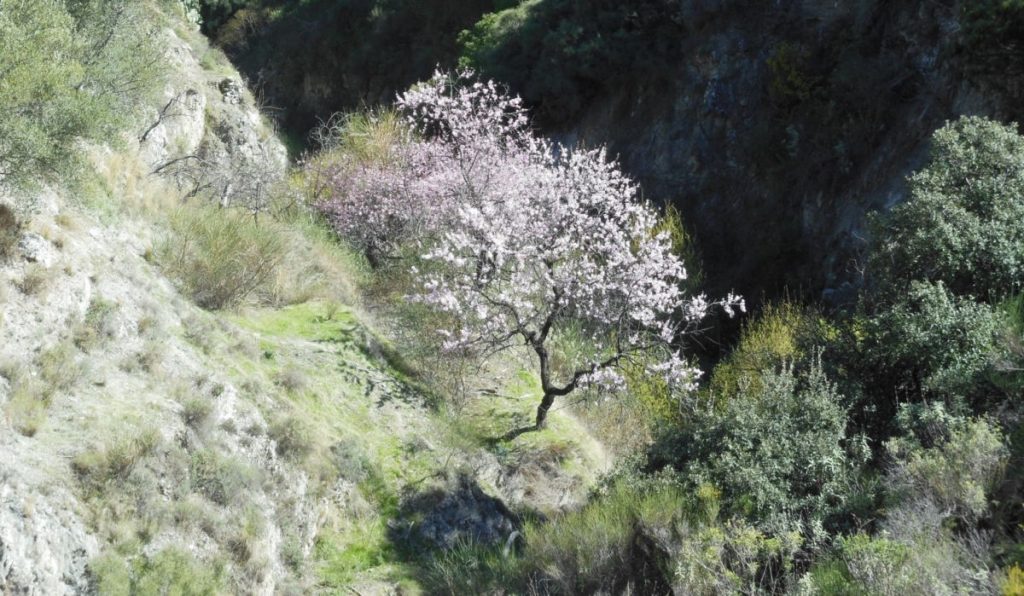Three years ago, it happened that I was in Andalucía in February. I arrived quite late the day before I had to work on a study in Lanjarón, near Granada. Due to the darkness, I did not realize that the mountains I drove up were covered by almond bloom. Driving to the apiary the next morning was one of the most beautiful ways getting to work I ever did. Lanjarón is well-known for its water, located in the Alpujarras, a mountain region in Andalucía. The region is well worth a trip, for many reasons. If you like bees, the best time though may be early spring, when everything is green and almonds, orange trees and spring flowers cover the mountains with different colours. Almonds are an important crop in this region.

Almond orchard at the top of a mountain.
The landscape in this period has a fragile beauty. It looks very dry, but paying attention you see life everywhere. For a bee lover, standing near one of these beautiful trees is very fruitful, many bees visit the flowers. I saw my very first Xylocopa violacea on them, many years ago (1998?). It was in another region of Andalucía; I was so excited that running after her I nearly fell down the hill. Risks of being a bee researcher… Since then, flowering almond trees have a special appeal for me and I get enchanted by their pink and white flowers.
Almond pollination
Another very early contact was the pollinator management: Osmia cornuta, a sister species of O. bicornis, is managed for this purpose in Spain. The cleptoparasites of both species are quite similar. Due to the importance of O. cornuta, their parasites are quite well studied. Therefore, this publication was very important for my master thesis.
The trees are highly dependent on insect pollination and with this very early bloom itcan get tricky. Honey bees do quite well, but communities together with other bee species do the best job. These pollinator communities rely on semi-natural habitat, i. e. uncultivated areas in the agricultural landscape. This is no problem in the Alpujarras, due to its geography it is difficult to intensify the cultivation. The growers may regret this, but for the bees and the pollination they provide this is a good thing.
On the other hand, there are other areas in the world with Mediterranean climate suitable for almonds. California may be the best known example. Here it is a whole “industry” to grow almonds, not just a traditional way of agriculture. The aim is to maximize the harvest and this means also to maximize the pollination efficacy. For this purpose, every year thousands of honey bee colonies “migrate” to California. It’s a big business for beekeepers: they do not harvest honey, but get money for the pollination services of their colonies. There are even brokerage services for beekeepers, there is much money in this business.
Gold rush for almonds?
The prices for almonds climbed in 2003. This led to an increase of the area with orchards, densely planted. Many growers wanted to profit from this market. In consequence, also the demand for pollination services increased. Beekeepers formerly asked permission for placing their colonies near the orchards, now they got asked to do so. You can read more details of the story on Randy Oliver’s blog. Almond pollination created a sort of gold rush, bringing fresh cash into US beekeeping.
But obviously, there are also problems. A “gold rush” can be over quite soon, with falling prices etc. Apparently, in this case the market regulated itself. However, many beekeepers still migrate their colonies across the country. This is stressful for honey bees, as I already pointed out some weeks ago. And there is again the usual issue when beekeeping meets agriculture: the pesticide exposure. There have been queen losses and other problems attributed to fungicides.
In my somewhat dreamful state of mind after looking at the photos from Lanjarón, I wonder if the problem itself is this overreacting after increasing prices – first the almonds, then those for pollination services. Treating almond trees and honey bee colonies as part of an “industry” seems a complete nonsense to me. Sometimes, remembering the warm spring sun in the Alpujarras, I wish for more understanding of living systems. But this dream may not be compatible with the culture of maximizing.



